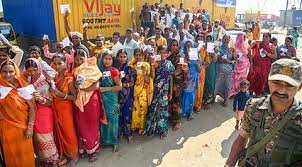While the RJD secured the highest vote count at 1.15 crore, its seat conversion collapsed due to fragmented vote geography and weak coordination with Congress and Left allies.
BY PC Bureau
As political rhetoric intensifies after the National Democratic Alliance’s (NDA) resounding victory in the 2025 Bihar Assembly elections, a deeper examination of official Election Commission data reveal broader voter participation, disciplined alliance management within the NDA, and ineffective coordination within the Mahagathbandhan (MGB).
Turnout: A Clear Rebuttal to Voter-Deletion Allegations
At the centre of the “vote chori” charge is the accusation that lakhs of voters were removed through the Election Commission’s Special Intensive Revision (SIR). But the turnout data tells a different story:
- 2020 turnout: 4.21 crore
- 2025 turnout: slightly over 5 crore
This nearly 20% rise in turnout strongly undermines the narrative of mass voter deletion. Instead, it indicates heightened voter mobilisation across the state — a trend visible in both urban and rural segments.
Analysts note that Bihar’s political landscape tends to respond decisively to waves of anti-incumbency or pro-incumbency. This year, the increased turnout appears to have benefited the NDA, which managed to expand its vote share through calibrated constituency-level mobilisation.
NDA’s Performance: Strike Rate Tells the Real Story
The NDA’s final tally of 202 out of 243 seats illustrates a near-clean sweep, but what truly explains the scale of victory is the remarkably high strike rate of each constituent party.
| NDA Party | Seats Won | Seats Contested | Strike Rate |
| BJP | 89 | 101 | 88% |
| JDU (Nitish Kumar) | 85 | 101 | 84% |
| Chirag Paswan | 19 | 29 | 65% |
| Jitan Manjhi | 5 | 6 | 83% |
| Upendra Kushwaha | 4 | 6 | 67% |
| Total NDA | 202 | 243 | 83% |
In Bihar’s fragmented multi-cornered contests, strike rate often matters more than absolute vote count. This year, the NDA achieved near-perfect conversion for two reasons:
- Surge in Votes for Both BJP and JDU
The BJP and JDU — the coalition’s twin pillars — substantially increased their vote numbers:
BJP:
- 2020 → 82 lakh votes, 74 seats
- 2025 → 1 crore votes, 89 seats
- Contested nine fewer seats but gained 15 more
JDU:
- 2020 → 64.85 lakh votes, 43 seats
- 2025 → 96.67 lakh votes, 85 seats
- Contested 14 fewer seats but nearly doubled seat tally
The data indicates not only a shift in voter preference but also a consolidation of the NDA’s core vote—traditionally fragmented across caste and regional lines.
READ: Lalu’s Daughter Quits Politics, Cuts Ties With Family
- Highly Effective Vote Transfer
Perhaps the most decisive factor was the smooth vote transfer across NDA partners. Constituencies allocated to smaller partners such as HAM and RLSP saw BJP and JDU voters backing them en masse. This synergy is rare in Bihar’s coalition politics, often marked by turf clashes and organisational friction.
This year, the NDA overcame those weaknesses, demonstrating a unified, election-focused machinery.
RJD’s Paradox: More Votes, Fewer Seats
One of the loudest claims from the Mahagathbandhan camp is that the RJD secured the highest number of votes — 1.15 crore — but ended up with just 25 seats, implying foul play. But the structural explanations are clear:
| Mahagathbandhan Party | Seats Won | Seats Contested | Strike Rate |
| RJD | 25 | 143 | 17% |
| Congress | 6 | 61 | 10% |
| Left Parties | 3 | 29 | 10% |
| Total MGB | 34 | 233 | 15% |
Why a High Vote Count Didn’t Convert into Seats
- RJD contested the most seats (143), naturally increasing its total vote count.
Higher vote totals don’t automatically translate into wins if the vote is spread thinly across constituencies. - Poor seat conversion due to weak alliance cohesion.
Congress and Left parties failed to supplement RJD’s votes with adequate transfer, leading to three-cornered contests in several seats. - NDA benefited from consolidation; MGB suffered from fragmentation.
The result: high raw votes for the RJD but low strike rate — a chronic issue for large parties in multi-party alliances.
RJD’s Vote Geography Made the Problem Worse
Analysts point out that the RJD’s votes:
- were concentrated heavily in traditional strongholds
- but thinly spread in regions where it needed tactical support from allies
- and saw significant erosion in urban and semi-urban constituencies
The pattern mirrors the 2020 trend but with deeper losses.
The Elector Count Controversy: EC Offers Clarification
The Congress also questioned the discrepancy between two EC figures:
- 7.42 crore electors in CEC Gyanesh Kumar’s October 6 note
- 7.45 crore electors in the post-poll press release
The Election Commission clarified that around 3 lakh voters were added after October 6 as part of routine updates, explaining the variation.
Election analysts emphasise that such additions are standard practice and do not indicate manipulation.
Conclusion: Data Points to Political Shift, Not Electoral Misconduct
The 2025 Bihar verdict represents a combination of:
- higher voter turnout
- consolidation of the NDA’s support base
- disciplined cross-party vote transfer
- organisational weakness within the Mahagathbandhan
The allegations of voter deletion or electoral manipulation find little to no support in official data.
Instead, the numbers reinforce a straightforward conclusion:
The NDA won because its voters turned out in higher numbers and its alliance functioned with exceptional efficiency.










